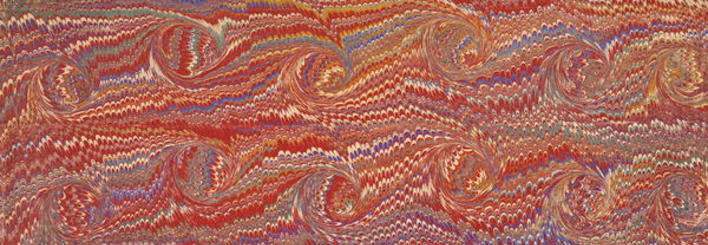Do you know what marbled paper is? At the Castello del Buonconsiglio in Trento, an exhibition tells you its story
From March 2 to May 5, 2019, the Buonconsiglio Castle in Trento is hosting the exhibition Floating Colors: Marbled Paper Between East and West, an exhibition, curated by Lorenzo Pontalti, that tells the public about the history of marbled paper over the centuries. Marbled paper is an ancient medium that originated in 12th-century Japan and came to Europe in the 16th century via Turkey (where it was called ebru, a term derived from the Persian abri, “cloud”): the fascination it exerted on artists from the Old Continent was immediate, and the Trentino exhibition brings to the halls of the Buonconsiglio Museum papers arriving from the ancient Orient, European marbled papers from the historic period, but also works by contemporary artists such as Philip Taaffe, Ugo Zovetti and Garip Aly, whose art is also characterized by the use of the ancient medium. Also on display are books and objects bound or covered with marbled paper, and there will be no shortage of insights into the technique used to create it.
Marbled paper, which as mentioned originated in Japan in the 12th century, employs the same tools as theart of calligraphy (from which in fact it originated): the slate stone(suzuri), the ink stick(sumi), the brush(hude) and rice paper(kami). As typical of Eastern art practices, the preparation of marbled paper, which is known in Japan as suminagashi, or “floating ink,” includes quasi-ritual aspects that encourage a meditative dimension: to obtain it, a few drops of water are placed on the slate stone and the ink is prepared, after which, with brushes, the surface of the water is brushed to create, through the ink and ox gall, circles and various shapes that are moved by the artist on the water. The last step involves gently resting the rice paper on the water so that the shapes created by the artist remain imprinted. The original technique was then further modified in the Middle East and Europe: in Turkey, for example, the water and ink bath was made thicker so that the artist could have more control over the shapes (which are more random in the Japanese technique), and this led artists to also produce animal and floral motifs as well as landscapes and even portraits.
Also attested in Turkey are the earliest examples of the use of decorated paper in the field of bookbinding, as guard papers placed before the text. Between the 15th and 16th centuries, the city of Istanbul became one of the centers of transmission of the art of marbling. There are many artists, as well as scientists and literati, who acquire the refined techniques of paper decoration, and through the trade of goods from the East, the technique of marbling, in the Turkish way, reaches Europe during the sixteenth century. Here, pictorial outcomes predominantly in imitation of marble veining assign it the term “marbled paper,” in French “papier marbré,” in English “paper marbling,” in Spanish “papel marmolado,” in German “Marmor-Papier.” In Europe, marbled paper loses its “spiritual” characteristics and is used almost only for practical and ornamental purposes: mainly, between the seventeenth and eighteenth centuries, in the field of bookbinding to embellish the covers of volumes and replace the use of leather with a cheaper solution, but also, in the Baroque era, to cover and decorate objects.
The exhibition at the Buonconsiglio Castle also includes a workshop conducted together with students from the Liceo Artistico “Alessandro Vittoria” high school in Trento, who, trained by the museum’s Educational Services in an alternating school-work project, will ensure that visitors to the exhibition, on weekends starting March 9, will witness the various stages of papermaking. Visitors will thus be guided through the discovery of this technique and will be able to experience it firsthand, creating colored papers that they can then take home.
Floating Colors: Marbled Paper Between East and West can be visited during the hours and with the ticket of Buonconsiglio Castle in Trento. For more information you can visit the Castello del Buonconsiglio website and the Trentino tourism website for suggestions on what to see in the city and the autonomous province of Trento.
 |
| Do you know what marbled paper is? At the Castello del Buonconsiglio in Trento, an exhibition tells you its story |
Warning: the translation into English of the original Italian article was created using automatic tools. We undertake to review all articles, but we do not guarantee the total absence of inaccuracies in the translation due to the program. You can find the original by clicking on the ITA button. If you find any mistake,please contact us.




























